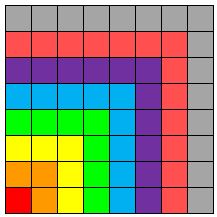This is the strategy for Week 1 in Grade 7 (which I assume
is equivalent to Year 8 in England).
Good: Pupils will
be following an algorithm and are using vocabulary, while also doing some
mental maths.
Bad: Pupils might
assume that in general all ‘series’ must start with 1.
It wasn’t made clear that for this algorithm to work it must start at 1.
Missed opportunity:
Why not mention that the answer is a square number? (Step 3 could easily be: “Square the quotient
obtained in Step 2”)
Why not explore why this is a square number? There are so many ways to do this. Here are a few I can think of immediately.]
If there are an odd number of terms we can use
the method from my previous post. With 1
+ 3 + 5 + 7 + 9 the middle number is 5 and there are 5 numbers. The sum is therefore 5 squared.
The same is true for any odd number.
For an even number of terms we can still use the
method from the previous post. With 1 + 3
+ 5 + 7 + 9 + 11 there are 6 terms and the middle is (1+11)/2= 6. The sum is 6 squared.
Ah: so the algorithm is really adding the
first and last terms, dividing by 2 and then squaring it.
We could also draw a picture:
Each colour shows a successive odd number, and after each
new colour has been added it is still a square.
We can also explore further why this pattern must increase
by an extra 2 each time. If we just add
on the same amount as last time, this is what happens:

To fill those gaps we need to add on an extra 2.


No comments:
Post a Comment